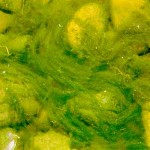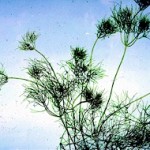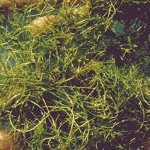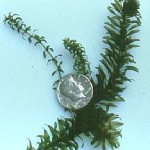TRUESDALE LAKE PROPERTY OWNERS ASSOCIATION
SOUTH SALEM, NY
|
AQUATIC MACROPHYTE SURVEY JULY 7, 2005 TRUESDALE LAKE SOUTH SALEM, NY |
I. Introduction
On July 7, 2005 Allied Biological, Inc. conducted a detailed aquatic macrophyte survey at Truesdale Lake, South Salem, New York. This survey is essential in order to determine the aquatic macrophytes that comprise the Truesdale Lake assemblage and their relative abundance and distribution. The data collected during this survey along with the maps generated are a required component of the New York State Pesticide Permit process.
II. Procedures
Before the survey began, random sample locations were plotted on a hand-drawn map of the lake focusing on the littoral areas. The points were aligned in transects in an effort to sample both the shoreline and open water communities. The total number of sample locations is based on the total acreage of the lake. As a rule of thumb, one sample location per acre (minimum 50 sample locations) is surveyed. If the lake is over 100 acres in size, the number of sample locations is reduced to about 100. Since every lake is different, the survey can focus on problematic locations according to the client’s instructions. It should also be noted that deeper water areas (total depth greater than 15 feet) are generally not surveyed due to the lack of aquatic macrophyte growth caused by poor light penetration. The sample locations are depicted on a map at the back of this report.
Using the hand-drawn map as a guide, the survey boat is piloted to the first sample location. On arrival, the GPS coordinates of the sample location are recorded using a TeeJet Smartpad II (ver. 4.02, or equivalent), and a Midtech High Accuracy Differential Receiver (RX 400p, or equivalent). The water depth is also measured, using a boat mounted depth finder, or a Fish Ray depth gun (Aquatic Ecosystems, model FR-100, or equivalent). The water depth was recorded on a field log, and is depicted on a map and a frequency distribution chart at the back of this report. Any other pertinent field notes regarding the sample location are also recorded on a field log. This procedure is then repeated for the remaining sample points.
Next, a weed anchor attached to a 30 foot-long piece of rope is tossed from a random side of the boat. It is important to toss the weed anchor the full 30 feet (a loop at the end of the rope should be placed on your wrist to prevent losing the anchor). The weed anchor is slowly retrieved along the bottom, and carefully hoisted into the boat. The weed mass is separated according to Genus, (or species, if possible) and assigned one of five densities, based on semi-quantitative metrics developed by Cornell University (Lord, et al, 2005). These densities are: No Plants (empty anchor), Trace (one or two stems per anchor), Sparse (three to 10 stems, but lightly covering the anchor), Medium (more than 10 stems, and covering all the tines of the anchor), or Dense (entire anchor full of stems, and one has trouble getting the mass into the boat). These densities are abbreviated in the field notes as 0, T, S, M, and D, along with the plant name or code. If a plant cannot be positively identified in the field, a sample is collected and placed in a bottle with a letter code (A, B, etc.). These bottles are placed in a cooler stocked with blue-ice packs, and returned to Allied Biological’s lab for identification. Regionally appropriate taxonomic keys were used to identify the aquatic macrophytes (see section V for a list of references).
The weed anchor used for aquatic macrophyte surveys has a specific design. It is constructed with two 13.5-inch wide metal garden rakes attached back to back with several hose clamps. The wooden handles are removed and a 30 foot-long rope is attached to the rake heads.
III. Macrophyte Summary
The following aquatic macrophytes were observed at Truesdale Lake on July 7, 2005. The respective plant densities are summarized on table #1. In addition, the abundance of each individual macrophyte as well as the total plant and Nitella distribution are depicted on separate maps located at the back of this report. Below is a short description of each macrophyte and a picture.
Benthic Filamentous Algae: Filamentous algae is a chain or series of similar algae cells arranged in an end-to-end manner. Benthic filamentous algae is attached to a hard substrate, such as logs, rocks, a lake bottom, or even other aquatic plants. When growing in heavy densities, benthic filamentous algae can appear as brown or green mats of vegetation that can reach the surface. When large pieces break off the bottom substrate they become floating filamentous algae patches. Benthic filamentous algae can comprise an entire range of morphologies, but flagellated taxa are far less common.
Nitella (Nitella sp. Common Names: stonewort, nitella): Nitella is actually a multi-branched algae that appears as a higher plant. It lacks conductive tissue and roots, using simple anchoring structures called rhizoids. Stem lengths can reach 0.5 meters, and leaves are arranged in whorls. Although similar in appearance to Chara, Nitella has smooth stems and branches, and lacks the distinct musky odor. Nitella inhabits soft sediments in the deeper water of lakes. It can be found as deep as 10 meters. Fish and waterfowl graze on Nitella.
Southern Naiad (Najas guadalupensis. Common Names: Southern water nymph, bushy pondweed): Southern naiad is an annual aquatic plant that can form dense stands of rooted vegetation. Its ribbon-like leaves are dark-green to greenish-purple, and are wider and less pointed than slender naiad. Flowers occur at the base of the leaves, but are so small, they usually require magnification to detect. Southern naiad is widely distributed, but is less common than slender naiad in northern zones. Southern naiad reproduces by seeds and fragmentation.
Elodea (Elodea Canadensis: Common Names: elodea, common waterweed): Common waterweed has slender stems that can reach a meter in length, and a shallow root system. The stem is adorned with lance-like leaves that are attached directly to the stalk that tend to congregate near the stem tip. The leaves are populated by a variety of aquatic invertebrates. Male and female flowers occur on separate plants, but it can also reproduce via stem fragmentation. Since common waterweed is disease resistant, and tolerant to low-light conditions, it can reach nuisance levels, creating dense mats that can obstruct fish movement, and the operation of boat motors.
IV. Discussion
At the back of this report are several maps that depict the distribution of aquatic macrophytes throughout Truesdale Lake. In addition to benthic filamentous algae, only three aquatic macrophytes were observed: Stonewort (Nitella sp., actually a multi-branched algae), Southern Naiad (Najas guadalupensis), and Common Waterweed (Elodea canadensis). Patches of dead vegetation were also observed. Truesdale Lake was treated 10 days earlier (June 27, 2005) with an aquatic herbicide. The target macrophytes were two pondweeds, Curly-leaf pondweed (P. crispus), and Leafy pondweed (P. foliosus) in heavy densities along the shoreline and the cove areas. Since neither of these pondweeds were observed during the July 7th survey, that treatment can be considered a success.
Benthic filamentous algae was scattered throughout the lake. It was heaviest in the southern portion of the lake (below the island), but trace amounts were also located on the east and west shores. The northeast cove also contained trace to dense amounts of benthic filamentous algae.
Stonewort was distributed throughout the entire lake, except the extreme southern cove. The heaviest densities occurred below the island, near the launch, and in the extreme northwest cove.
Southern Naiad was observed mostly in the northern half of the lake but almost exclusively in trace amounts. Trace amounts were localized along the east and west shores, and a single sparse patch was located in the northeast cove. Since Southern Naiad is a late season annual, the July 7th survey is probably not an accurate representation of its true distribution later in the season.
Common Waterweed was only observed at three sample locations in Lake Truesdale. Trace amounts were located just north of the southern island. One of these patches was along the west shore, the other closer to the middle of the lake. A sparse amount was also located along the eastern shore.
V. References
Through the Looking Glass: A Field Guide to Aquatic Plants. 1999. Borman, et al. Wisconsin Lakes Partnership, University of Wisconsin-Extension. Reindl Printing, Inc. Merrill, WI.
Aquatic and Wetland Plants of Florida. 1979. Tarver, et al. Bureau of Aquatic Plant Research and Control, Florida Department of Natural Resources. Tallahassee, Florida.
A Manual of Aquatic Plants. 1972. Fassett, Norman C. The University of Wisconsin Press, Milwaukee.
Aquatic Vegetation of New Jersey. 1962. Fairbrothers, et al. Extension Bulletin 382. Extension Service, College of Agriculture, Rutgers University, New Brunswick, NJ.
Effective Aquatic Plant Monitoring: Data and Issues from Waneta Lake. 2005. Lord et al. Presentation at the Northeast Aquatic Plant Management Society Annual Meeting. Saratoga Springs, NY.
Figure 1Â Â Â Â Â Â Â Â Â Â Â Â Â Â Â Water depth Frequency Chart
Water Depth (feet)





